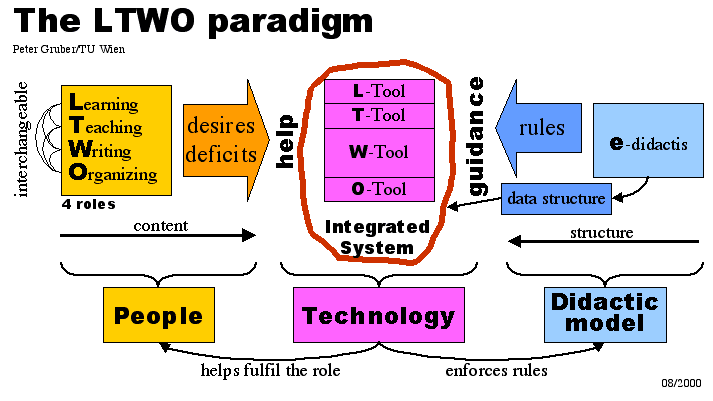The LTWO-paradigm is based on the desire to offer didactically correct e-education services. Information technology (IT) can play a major role in achieving this goal, by helping educators to produce didactically correct content and by enforcing rules set out by an e-didactics. Its aim is to empower education institutions to create e-education services without the outside help of IT or e-didactics specialists. It is based on four principles:
- Four roles. E-education consists of the four roles L(earning), T(eaching), W(riting) and O(rganizing). These roles are not linked to a person, everybody can take any role. (A student can be teaching when he gives a presentation). All four roles have to be integrated. No role can be fully replaced by IT.
- Content is king. Currently most of the cost of an e-education system is linked to technical aspects such as multimedia programming, design or illustration. An LTWO-conform IT system must be so easy to use, that a content provider (W) can create an e-lesson without the help of an IT professional; such shifting resources from IT to content.
- New E-didactics. To provide didactically correct e-lessons, a model of e-didactics has to be formulated. Normally, one product will only support one e-didactics. So, by using a certain product one automatically employs a certain e-didactics. Therefore the didactic model that is built into a product has to be clearly stated.
- Help & guidance. IT cannot replace educators, but it can facilitate consistency and didactic correctness in two ways: by helping the 4 players to fulfill their role and by guiding them to stick to didactic rules.

Overview of the LTWO-paradigm. Technology (center) is the link between people (left) and didactics (right).
Implementing the LTWO paradigm
First, a didactic model has to be developed or adopted. It is the fundament of each e-education system as all choices in the system design process and all rules for the user are based on this model.In the case of ESPACE, the didactic model was based on perception theory. The average learner has very short periods of full concentration. Thus, a lesson (module) has to be chopped into very small pieces (learning elements). They consist of a text of less than 100 words (learning atom). Furthermore it is important to open the student's mind for each of these learning elements. That is why they all start with a multimedia element (mostly a picture). To prevent the user from going too fast through a module, there are activities away from the computer at certain points. To help self-assessment, a question is attached to each learning element. These questions are posed at the end of each module.
One can draw the conclusion that didactic considerations totally dictated the data structure of the ESPACE system. Each field in the database that underlies the ESPACE system has a specific didactic function.
| Field name | Used for | Didactic background |
| Title | Title of the learning element | - |
| Multimedia Element | Illustration, film or interactive media | Open the pupil's mind, attract attention |
| Learning atom | Text of less than 100 words | Reading the text should not take more than 45seconds; the maximum interval of attention; optimal for memorizing |
| Activity away from the computer | Practical tasks such as experiments, discussions with classmates | Break the flow of learning elements; give the brain time to store new facts in long-term memory |
| Self testing question | A multiple-choice question plus an explanatory answer | Self-assessment; motivation |
Basis for the development of an e-education product is a deficit-and-desire analysis for each of the roles. This analysis is used to define the feature sets of the tools, which help individuals to fulfill their role. The results of the ESPACE-survey are summed up in table 1.
| Role | Desires | Deficits | Tool |
| Learning (Student) | Fun, help to concentrate | Limited time, concentration, memory capacity | Learning tool |
| Teaching (Teacher) | More impact on students, good didactics | No experience with multimedia technology, no knowledge of e-didactics | Lesson builder |
| Writing (Author) | Large audience, possibility of frequent changes | No knowledge of didactics, no experience with multimedia technology | Authoring tool |
| Organizing (Course provider) | High quality and up-to-date education; simple to organize; consistent | Limited time, resources | Report generator |
Based on the e-didactics, rules are then established to reduce the above mentioned features. This makes the tools easier to use and prevents non-didactic e-lessons. In the ESPACE case, some severe restrictions were imposed upon the user, specially the author. On top of the already mentioned reasons, ESPACE is a European project with authors in seven countries that met rarely. In order to guarantee consistency, the author’s choice was limited in the following ways:
- The author has no influence on the design.
- The author has to stick to the structure of a learning element. The system issues warnings if rules are not obeyed (e.g. maximum length of the learning atom)
- They author can only add one multimedia element to each learning element.
- Avoid the cost for multimedia design and programming by empowering authors to enter learning elements themselves into the database (authoring tool)
- Help authors to transfer existing knowledge and material into a didactically correct and impressive e-lesson
- Make the system easy to use by trading flexibility for ease-of-use; thus avoiding training cost for deploying the system
- Use WEB technology as a proven multi-platform standard with free client programs (WEB browsers)
In LTWO paradigm information technology helps people to fulfil their roles while enforcing rules laid out by an e-didactics. The result is an easy-to use, affordable and fast software product for e-education.